
Anointing of the sick, known also by other names such as unction, is a form of religious anointing or "unction" for the benefit of a sick person. It is practiced by many Christian churches and denominations.

Anointing is the ritual act of pouring aromatic oil over a person's head or entire body.
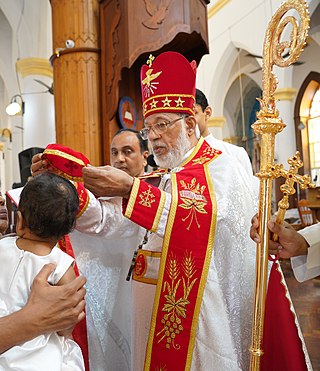
Chrismation consists of the sacrament or mystery in the Eastern Orthodox, Oriental Orthodox and Eastern Catholic churches, as well as in the Assyrian Church of the East initiation rites. The sacrament is more commonly known in the West as confirmation, although some languages such as Italian and Portuguese normally use the terms cresima and crisma ("chrismation") rather than confermazione or confirmação, respectively ("confirmation").

The epiclesis refers to the invocation of one or several gods. In ancient Greek religion, the epiclesis was the epithet used as the surname given to a deity in religious contexts. The term was borrowed into the Christian tradition, where it designates the part of the Anaphora by which the priest invokes the Holy Spirit upon the Eucharistic bread and wine in some Christian churches. In most Eastern Christian traditions, the Epiclesis comes after the Anamnesis ; in the Western Rite it usually precedes. In the historic practice of the Western Christian Churches, the consecration is effected at the Words of Institution though during the rise of the Liturgical Movement, many denominations introduced an explicit epiclesis in their liturgies.
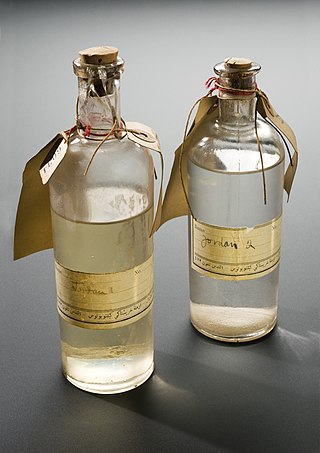
Holy water is water that has been blessed by a member of the clergy or a religious figure, or derived from a well or spring considered holy. The use for cleansing prior to a baptism and spiritual cleansing is common in several religions, from Christianity to Sikhism. The use of holy water as a sacramental for protection against evil is common among Lutherans, Anglicans, Roman Catholics, and Eastern Christians.

Chrism, also called myrrh, myron, holy anointing oil, and consecrated oil, is a consecrated oil used in the Catholic, Eastern Orthodox, Oriental Orthodox, Assyrian, Nordic Lutheran, Anglican, and Old Catholic churches in the administration of certain sacraments and ecclesiastical functions.

In Eastern Orthodox and Byzantine Catholic churches, an entrance is a procession during which the clergy enter into the sanctuary through the Holy Doors. The origin of these entrances goes back to the early church, when the liturgical books and sacred vessels were kept in special storage rooms for safe keeping and the procession was necessary to bring these objects into the church when needed. Over the centuries, these processions have grown more elaborate, and nowadays are accompanied by incense, candles and liturgical fans. In the liturgical theology of the Eastern Orthodox Church, the angels are believed to enter with the clergy into the sanctuary, as evidenced by the prayers which accompany the various entrances.
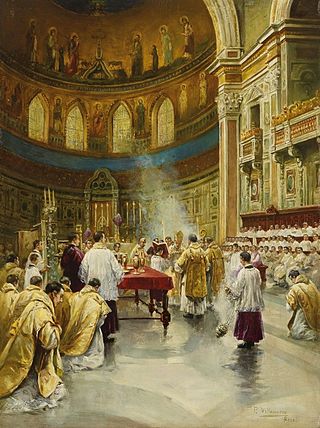
The Chrism Mass is a religious service held in certain Christian denominations, such as Roman Catholicism, Lutheranism, and Anglicanism. It is usually celebrated each year on Maundy Thursday or on another day of Holy Week. During the ceremony, the holy oils used for sacraments and rituals are blessed or consecrated.

In the Catholic Church, the anointing of the sick, also known as Extreme Unction, is a Catholic sacrament that is administered to a Catholic "who, having reached the age of reason, begins to be in danger due to sickness or old age", except in the case of those who "persevere obstinately in manifest grave sin". Proximate danger of death, the occasion for the administration of Viaticum, is not required, but only the onset of a medical condition of serious illness or injury or simply old age: "It is not a sacrament for those only who are at the point of death. Hence, as soon as anyone of the faithful begins to be in danger of death from sickness or old age, the fitting time for him to receive this sacrament has certainly already arrived."
The Lity or Litiyá is a festive religious procession, followed by intercessions, which augments great vespers in the Eastern Orthodox and Byzantine Catholic churches on important feast days. Following a lity is another liturgical action, an artoklasia, and either of these terms may be used to describe both liturgical actions collectively.

The Church of Saint Elian is a church in Homs, Syria, located along Tarafa bin al-Abd Street near the Gate of Palmyra. The Feast of St. Elian is held annually at the church on February 6 and attracts a large number of pilgrims from all around Syria. Elian is also known in English as Julian. The only other Orthodox Christian church in the world named after St. Julian/Elian is in Brownsville, Pennsylvania, United States, and named St Ellien Antiochian Orthodox Church, built in 1917.

The accession of the King of France to the royal throne was legitimized by a ceremony performed with the Crown of Charlemagne at the Reims Cathedral. In late medieval and early modern times, the new king did not need to be anointed in order to be recognized as French monarch but ascended upon the previous monarch's death with the proclamation "Le Roi est mort, vive le Roi!"
The Lutheran sacraments are "sacred acts of divine institution". They are also defined as “an outward and visible sign of an inward and spiritual grace.”.

Among Eastern Orthodox and Eastern-Rite Catholic Christians, holy water is blessed in the church and given to the faithful to drink at home when needed and to bless their homes. In the weeks following the Feast of Epiphany, clergy visit the homes of parishioners and conduct a service of blessing by using the holy water that was blessed on the Feast of Theophany. For baptism, the water is sanctified with a special blessing.

Blessed salt has been used in various forms throughout the history of Christianity. Among early Christians, the savoring of blessed salt often took place along with baptism. In the fourth century, Augustine of Hippo named these practices "visible forms of invisible grace". However, its modern use as a sacramental remains mostly limited to its use with holy water within the Anglican Communion and Roman Catholic Church.

There are seven sacraments of the Catholic Church, which according to Catholic theology were instituted by Jesus Christ and entrusted to the Church. Sacraments are visible rites seen as signs and efficacious channels of the grace of God to all those who receive them with the proper disposition.

The Order of Christian Initiation of Adults (Latin: Ordo initiationis christianae adultorum), or OCIA, is a process developed by the Catholic Church for its catechumenate for prospective converts to the Catholic faith above the age of infant baptism. Candidates are gradually introduced to aspects of Catholic beliefs and practices. The basic process applies to adults and children who have reached catechetical age. In many English speaking countries, it is called Rite of Christian Initiation of Adults (RCIA). In the United States, the name was changed to the OCIA in 2021 to reflect greater fidelity to the original Latin, although this change has yet to be officially approved by the Dicastery for Divine Worship and the Discipline of the Sacraments.
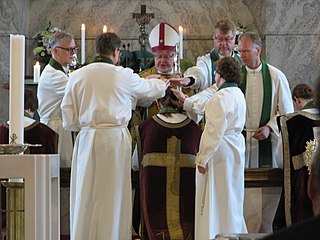
In Christianity, the laying on of hands is both a symbolic and formal method of invoking the Holy Spirit primarily during baptisms and confirmations, healing services, blessings, and ordination of priests, ministers, elders, deacons, and other church officers, along with a variety of other church sacraments and holy ceremonies.

The expression minor exorcism can be used in a technical sense or a general sense. The general sense indicates any exorcism which is not a solemn exorcism of a person believed to be possessed, including various forms of deliverance ministry. This article deals only with the technical sense which specifically refers to certain prayers used with persons preparing to become baptised members of the churches which makes use of such rites. These prayers request God's assistance so that the person to be baptised will be kept safe from the power of Satan or protected in a more general way from temptation.
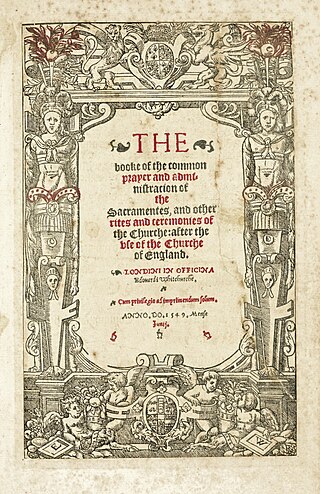
The 1549 Book of Common Prayer (BCP) is the original version of the Book of Common Prayer, variations of which are still in use as the official liturgical book of the Church of England and other Anglican churches. Written during the English Reformation, the prayer book was largely the work of Thomas Cranmer, who borrowed from a large number of other sources. Evidence of Cranmer's Protestant theology can be seen throughout the book; however, the services maintain the traditional forms and sacramental language inherited from medieval Catholic liturgies. Criticised by Protestants for being too traditional, it was replaced by the significantly revised 1552 Book of Common Prayer.

















